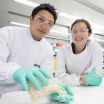Finding new ways to make drugs
Chemists have developed a revolutionary way to manufacture natural chemicals by clipping smaller molecules together like Lego. They used the new method to assemble a scarce anti-inflammatory drug with potential to treat cancer and malaria, pseudopterosin
2014-11-18
(Press-News.org) Chemists have developed a revolutionary new way to manufacture natural chemicals and used it to assemble a scarce anti-inflammatory drug with potential to treat cancer and malaria.
The breakthrough could lead to new and cheaper ways to produce rare drugs in large quantities.
"We took small molecules and clipped them together like Lego," said lead researcher Professor Michael Sherburn, from the Research School of Chemistry at The Australian National University (ANU).
"The building blocks are carefully designed in such a way that the first reaction generates a product perfectly primed for the second. It's quite magical. This means you can efficiently build large and complex molecules."
Medicines of this type have traditionally been made in a cumbersome way. Chemists take a related molecule and renovate it. This is a lengthy process, with unwanted structural features being ripped out and replaced.
"This leads to a lot of waste," Professor Sherburn said.
The group trialed their innovative new method by making pseudopterosin, a powerful anti-inflammatory and analgesic drug, which is currently only available in tiny quantities extracted from fan coral found in the Bahamas.
The work began as blue-sky research, with the researchers trying to work out a way to make supposedly impossible molecules of cross-conjugated hydrocarbons.
Before trying the experiments the team ran simulations on the Raijin supercomputer, which indicated that their method had potential.
"Ours is an empowering and enabling technique, allowing a smarter and faster way to make important substances," said Dr Chris Newton, who did the research in the laboratory as a PhD student.
"The pseudopterosin synthesis is the tip of the iceberg. We are well on the way to efficient syntheses of other important drugs.
"There is a potential for industrial-scale manufacture, too, which will take the pressure off species which are being harvested for drugs," he said.
INFORMATION:
[Attachments] See images for this press release:

ELSE PRESS RELEASES FROM THIS DATE:
2014-11-18
Scientists in Australia have used historic media to measure the decline in Queensland's pink snapper fishery, highlighting a drop of almost 90 per cent in catch rates since the 19th Century.
Researchers from the ARC Centre of Excellence for Coral Reef Studies (Coral CoE) at the University of Queensland and the Department of Agriculture Fisheries and Forestry examined thousands of newspaper articles dating back to1870 to reveal the historic catch rates for the iconic Queensland fishery.
"We found that 19th century recreational fishers would regularly catch hundreds of ...
2014-11-18
Case Western Reserve researchers have developed a procedure that restores function to muscles involved in the control of breathing - even when they have been paralyzed for more than a year. The breakthrough offers hope that one day patients with severe spinal cord injuries will be able to breathe again without the assistance of a ventilator.
Principal investigator Philippa M. Warren, PhD, presented the results Nov. 17 at Neuroscience 2014, the annual meeting of the Society for Neuroscience. The research represents a critical step forward in efforts to reverse even long-term ...
2014-11-18
Ferroptosis is a recently recognized form of regulated necrosis. Up until now, this form of cell death has only been thought to be a possible therapeutic approach to treat tumour cells. Yet, ferroptosis also occurs in non-transformed tissues as demonstrated by this study, thus implicating this cell death pathway in the development of a wide range of pathological conditions. More specifically, the deletion of the ferroptosis-regulating enzyme Gpx4* in a pre-clinical model results in high ferroptosis rates in kidney tubular epithelial cells causing acute renal failure.
Specific ...
2014-11-18
The increasing complexity and interconnection of socioeconomic and environmental systems leaves them more vulnerable to seemingly small risks that can spiral out of control, according to the new study, published in the journal Proceedings of the National Academy of Sciences.
The study examines risks are perceived as extremely unlikely or small, but because of interconnections or changes in systems, can lead to major collapses or crises. These risks, which the researchers term "femtorisks," can include individuals such as terrorists, dissidents, or rogue traders, or factors ...
2014-11-18
This news release is available in German. Scientists have been conducting research on micrometre-sized actuators which one day may make it possible to transport drugs or chemical sensor molecules to specific locations throughout the human body. Researchers at ETH Zurich have now taken the development of such micro-devices a crucial step forward: a new production technology and new materials have made it possible to manufacture tiny actuators in any form and optimise them for future applications.
The elongated actuators elements, which can move through liquids, possess ...
2014-11-18
Melbourne researchers have identified why some people with coeliac disease show an immune response after eating oats.
The researchers have identified the key components in oats that trigger an immune response in some people with coeliac disease. The findings may lead to better tests for oat toxicity, and have implications for new treatments being developed for coeliac disease.
As many as one in 60 women and one in 80 men in Australia have coeliac disease, an autoimmune condition caused by consuming gluten, a protein found in wheat, rye and barley. The abnormal immune ...
2014-11-18
Young people growing up in impoverished neighborhoods who perceive their poor communities in a positive light report better health and well-being than those with worse perceptions of where they live, new research led by the Johns Hopkins Bloomberg School of Public Health suggests.
As part of the Well-Being of Adolescents in Vulnerable Environments (WAVE) study, researchers surveyed nearly 2,400 adolescents ages 15 to 19 in poor sections of five cities across the world: Baltimore; New Delhi, India; Ibadan, Nigeria; Johannesburg, South Africa; and Shanghai, China. The survey ...
2014-11-18
Blocking a key receptor in brain cells that is used by oxygen free radicals could play a major role in neutralizing the biological consequences of Alzheimer's disease, according to researchers at Temple University.
The researchers' findings, "Modulation of AD Neuropathology and Memory Impairments by the Isoprostane F2α Is Mediated by the Thromboxane Receptor," were published Oct. 13 by the journal Neurobiology of Aging.
The human body's use of oxygen to produce energy often results in the formation of highly reactive molecules called oxygen free radicals. Oxidative ...
2014-11-18
As genome sequencing has gotten faster and cheaper, the pace of whole-genome sequencing has accelerated, dramatically increasing the number of genomes deposited in public archives. Although these genomes are a valuable resource, problems can arise when researchers misapply computational methods to assemble them, or accidentally introduce unnoticed contaminations during sequencing.
The first complete bacterial genome, Haemophilus influenzae, appeared in 1995, and today the public GenBank database contains over 27,000 prokaryotic and 1,600 eukaryotic genomes. The vast majority ...
2014-11-18
The landmark discovery of a tiny defect in a vital heart protein has for the first time enabled heart specialists to accurately pinpoint a therapeutic target for future efforts in developing a drug-based cure for cardiovascular diseases.
Scientists from Cardiff University and the Slovak Academy of Science have identified defects in a colossal heart protein which often leads to stroke and heart failure.
"Our research has revealed that a genetic alteration in the largest membrane protein, responsible for triggering each and every heartbeat, produces a small structural ...
LAST 30 PRESS RELEASES:
[Press-News.org] Finding new ways to make drugs
Chemists have developed a revolutionary way to manufacture natural chemicals by clipping smaller molecules together like Lego. They used the new method to assemble a scarce anti-inflammatory drug with potential to treat cancer and malaria, pseudopterosin


